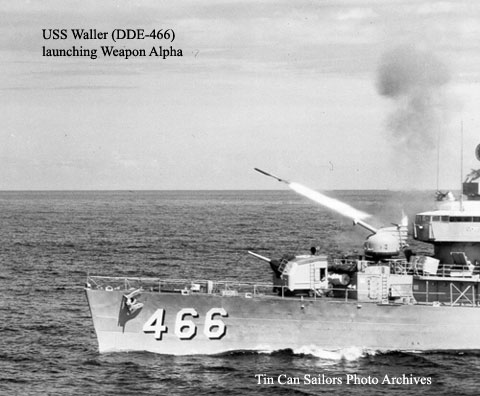The MK 108 Antisubmarine Rocket Launcher
By Robert F. Sumrall

The standard World War II antisubmarine warfare (ASW) battery installed in the U.S. Navy’s destroyer and destroyer escort forces changed little until the mid-1950s when the first of the new Soviet submarines, spawned from the technology of the German Type XXI U-boats, began to appear. As new ASW weaponry was developed to address the Soviet submarine threat, numerous destroyers and destroyer escorts were modified to carry the weapons. One of the new weapons, the Mark 108 rocket launcher, was installed aboard the destroyer leader Norfolk, a number of Fletcher- and Gearing-Class destroyers, and several Dealey-Class destroyer escorts.
The Mark 108 launcher, often referred to as “Weapon Able” or, later, “Weapon Alpha,” was a remotely controlled, automatically loaded rocket launcher for firing the 12.75-inch Mark 1 and Mark 2 underwater rockets. Major units included the mount, ready-service magazine with rocket hoist, lower rocket hoist, and control equipment.
The mount included the rocket-launcher guide, carriage, stand, shield, and power drives. The guide was a 12.75-inch tube open at the breech end and muzzle and pivoted in the trunnion bearings of the pedestal. The guide could be depressed 10 degrees and elevated to its loading angle of 90 degrees. A circular blast deflector was attached near the muzzle to deflect the rocket blast as the rocket left the guide. The pedestal was mounted on a base-ring-type carriage that supported the rotating assembly in the stand. The stand was a circular assembly mounted to the deck, containing the roller bearing paths and the training rack. The mount was provided with a circular shield for protection against the weather and rocket blast that was not dissipated by the muzzle deflector. A blast deflector was also fitted to the shield aft of the breech to collect the gasses from the rocket ignition and vent them directly upward over the shield. Power drives for training and elevating the mount were located on each side of the pedestal within the shield.

The ready-service magazine was located directly below the mount stand and featured a vertical, rotating rocket-handling ring, similar to the “merry-go-round” arrangement of the 5-inch main-battery guns that held twenty-two rockets. The handling ring was not concentric with the mount but offset to intersect the center of the mount and align with the guide in its vertical loading position. The rocket hoist was on the periphery of the handling ring directly below the center of the mount and hoisted rockets upward into the guide during loading.
The lower rocket hoist was in the main magazine below the ready-service magazine. Positioned under the periphery of the rocket-handling ring opposite the ready-service hoist above, it hoisted rockets upward into the ring.
The controls and associated equipment were located and operated within the bulkheads of the ready-service magazine compartment. The launcher could fire either the Mark 1 or Mark 2 rockets at a rate of 12 rounds per minute. For ASW training exercises, the Mark 19 rocket launcher could be inserted in the guide if the Mark 15 launcher to fire the 4-inch, subcaliber Mark 2 Rocket.
